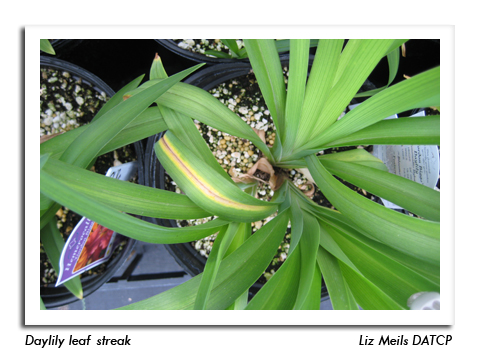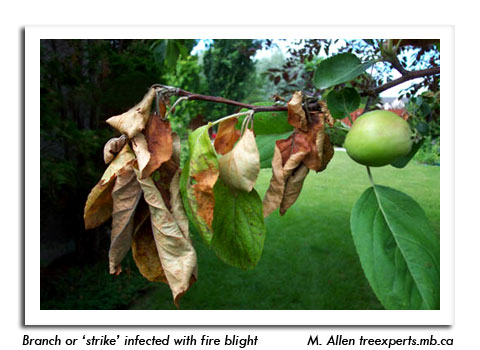
 |
|
|
Nursery & Forest
Volume 59 Number 8 Date 06/19/2014 DAYLILY LEAF STREAK - Several daylily varieties ('Marque Moon', 'Platinum Palette Calypso Coral', and others) at nurseries in Ashland, Clark, Douglas, Jefferson, Milwaukee, Vilas, and Waukesha counties were infected with this fungal disease, characterized by a central, yellow streak along the leaf midvein that starts at the leaf tips and progresses downward. Removing infected leaves as they appear, minimizing overhead watering, and fertilizing and watering plants properly to promote growth of new leaves should help to reduce the spread of this primarily cosmetic daylily disorder. Complete removal of dead leaves each fall is also recommended to eliminate the source of the leaf streak fungus. TAR SPOT - The pale yellow lesions appearing on Amur maple, red maple 'Burgundy Bell', and silver maple 'Silver Queen' in Clark and Monroe counties are early symptoms of tar spot, a cosmetic fungal leaf spot disease. Severely infected foliage will soon develop raised, black, tar-like spots and may drop prematurely. Tar spot is an aesthetic disease best controlled by clearing and destroying infected leaves in fall to prevent the spores from spreading. If treatment is justified, three fungicide applications are necessary for control: one at bud break, one when leaves are half expanded, and one when leaves are fully expanded. SHOT HOLE DISEASE - Nursery inspectors observed this disease on chokecherry 'Canada Red' and 'Schubert' as well as on the weeping cherry 'Snow Fountains' in Jefferson, Monroe, Ozaukee and Waukesha counties. Shot hole disease is common on Prunus species and can be caused by various bacterial or fungal pathogens. Symptoms first appear on new leaves and shoots as small reddish or purplish spots that enlarge, turn necrotic, and then fall out as foliage expands, leaving a 'shot hole' appearance. On fruits, dark lesions develop and eventually become rough and corky. Determining the causal agent is difficult once symptoms are advanced and the initial leaf spots have become leaf holes. Chemical treatment is not advised unless a specific bacterial or fungal cause can be identified and the severity of symptoms warrants control. FIRE BLIGHT - Warm, humid weather this week favored development of the fire blight bacterium in nurseries and orchards. The pathogenic bacteria multiply on the edge of cankers formed the previous year and are disseminated by insects, wind, and rain splash. During this week's inspections, fire blight was found on the pear cultivar 'Cleveland Select' in a Monroe County nursery. Symptoms are cankered twigs and branches with blackened, drooping foliage that appear to have been scorched. Prompt removal of cankered branches or "strikes" 12 inches beyond the diseased area can reduce the problem. Sterilizing tools with a 10% bleach solution between cuts is recommended. GYPSY MOTH - A report from the DNR Northern Region Forest Health Specialist predicts noticeable defoliation again this summer for aspen stands south of Ashland where severe defoliation occurred in 2013. Surveys this spring found an abundance of egg masses on the boles of aspens and tag alders, apparently protected by last winter's deep insulating snow cover. Larvae in Ashland County were predominantly in the second and third instars as of June 15 and their damage should be evident later this month. NR40 INVASIVE SPECIES RULE - Recent garden center inspections in Milwaukee and Washington counties found the invasive plants, Ampelopsis brevipedunculata 'Elegans' (variegated porcelain berry), Myriophyllum brasiliensis (red-stemmed parrot feather) and Lonicera japonica 'Halliana' (Hall's honeysuckle) being offered for sale. These plants are categorized as prohibited under the DNR's Chapter NR 40 Invasive Species Rule and must be removed from sale. Many additional aquatic and terrestrial plants commonly used in the nursery industry will be listed as prohibited or restricted once revisions to the DNR's Chapter NR 40 Invasive Species Rule take effect next fall. The addition of 42 new prohibited plant species and 29 new restricted plants has been proposed. Nursery operators and brokers have until June 30 to submit comments on the proposed changes: http://dnr.wi.gov/topic/Invasives/classification.html . -- Ellen Hermanson, DATCP Nursery Inspector EMERALD ASH BORER - Adults are emerging in southern Wisconsin and were observed on June 16 in Washington and Dane counties. Beetle emergence typically begins when the black locust tree is in full bloom, or around 450 growing degree days (base 50°F). Degree day accumulations as far north as Medford in Taylor County are beyond this threshold and most confirmed infestations in the state are experiencing initial beetle flight this week. Emerald ash borer adults can be observed feeding on ash leaves, on the bark of the main stem, or in the vicinity of ash trees. The metallic green beetles differ from similar green beetles by having a purple-red abdomen which is visible during flight. -- Renee Pinski, DATCP Forest Entomologist 





|
|
|